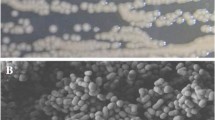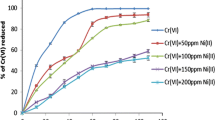Abstract
Biological methods have been successfully used to mitigate heavy metal pollution problem in wastewater. The present study was aimed towards isolation of a novel indigenous bacterial strain, Acinetobacter guillouiae from activated sludge and its subsequent application in remediation of copper (Cu2+) from aqueous solution. Kinetic study of bioremediation was performed for initial Cu2+ concentrations ranging from 40 to 150 mg L−1. Optimum values of nutrient dosage, pH, macronutrients [Nitrogen (N)–Phosphorus (P)–Potassium (K)] dosage, aerobic and facultative anaerobic conditions, temperature, and inoculum volume were determined by conducting separate batch bioremediation studies at 80 mg L−1 initial concentration of Cu2+. Kinetic study showed that A. guillouiae removed 98.7 % Cu2+ for 80 mg L−1 initial concentration of Cu2+ after 16 h at an optimum solution pH of 7.0. Results also revealed that A. guillouiae showed maximum growth at double the standard composition of N, P and standard composition of K in nutrient dosage. Experimental data obtained in present study were utilized to validate different growth kinetic models such as Monod, Powell, Haldane, Luong, and Edwards. Growth kinetics of A. guillouiae was better understood by Luong model (R 2 = 0.97). Higher values of coefficient of determination (R 2 = 0.97–0.99) confirmed the suitability of the three-half-order kinetic model for representing the Cu2+ bioremediation. A. guillouiae showed a robust removal mechanism for the bioremediation of Cu2+.










Similar content being viewed by others
References
Nriagu JO, Pacyna JM (1988) Quantitative assessment of worldwide contamination of air, water and soils by trace metals. Nature 333(6169):134–139
Gadd GM (1993) Tansley review no. 47. Interactions of fungi with toxic metals. New Phytol 124(1):25–60. doi:10.2307/2558069
Akar T, Tunali S (2005) Biosorption performance of Botrytis cinerea fungal by-products for removal of Cd(II) and Cu(II) ions from aqueous solutions. Miner Eng 18(11):1099–1109. doi:10.1016/j.mineng.2005.03.002
Yao ZY, Qi JH, Wang LH (2010) Equilibrium, kinetic and thermodynamic studies on the biosorption of Cu(II) onto chestnut shell. J Hazard Mater 174(1–3):137–143. doi:10.1016/j.jhazmat.2009.09.027
Jaman H, Chakraborty D, Saha P (2009) A study of the thermodynamics and kinetics of copper adsorption using chemically modified rice husk. CLEAN Soil Air Water 37(9):704–711. doi:10.1002/clen.200900138
Mittal A, Mittal J, Malviya A, Kaur D, Gupta VK (2010) Decoloration treatment of a hazardous triarylmethane dye, Light Green SF (yellowish) by waste material adsorbents. J Colloid Interface Sci 342(2):518–527. doi:10.1016/j.jcis.2009.10.046
Mittal A, Kaur D, Mittal J (2009) Batch and bulk removal of a triarylmethane dye, Fast Green FCF, from wastewater by adsorption over waste materials. J Hazard Mater 163(2–3):568–577. doi:10.1016/j.jhazmat.2008.07.005
Mittal A, Gupta VK (2010) Adsorptive removal and recovery of the azo dye Eriochrome Black T. Toxicol Environ Chem 92(10):1813–1823. doi:10.1080/02772248.2010.485998
Dönmez G, Aksu Z (1999) The effect of copper(II) ions on the growth and bioaccumulation properties of some yeasts. Process Biochem 35(1–2):135–142. doi:10.1016/S0032-9592(99)00044-8
Malik A (2004) Metal bioremediation through growing cells. Environ Int 30(2):261–278. doi:10.1016/j.envint.2003.08.001
Andreazza R, Pieniz S, Wolf L, Lee M-K, Camargo FAO, Okeke BC (2010) Characterization of copper bioreduction and biosorption by a highly copper resistant bacterium isolated from copper-contaminated vineyard soil. Sci Total Environ 408(7):1501–1507. doi:10.1016/j.scitotenv.2009.12.017
Casiot C, Morin G, Juillot F, Bruneel O, Personné J-C, Leblanc M, Duquesne K, Bonnefoy V, Elbaz-Poulichet F (2003) Bacterial immobilization and oxidation of arsenic in acid mine drainage (Carnoulès creek, France). Water Res 37(12):2929–2936. doi:10.1016/S0043-1354(03)00080-0
Deng X, Li QB, Lu YH, Sun DH, Huang YL, Chen XR (2003) Bioaccumulation of nickel from aqueous solutions by genetically engineered Escherichia coli. Water Res 37(10):2505–2511. doi:10.1016/S0043-1354(03)00027-7
Loukidou MX, Matis KA, Zouboulis AI, Liakopoulou-Kyriakidou M (2003) Removal of As(V) from wastewaters by chemically modified fungal biomass. Water Res 37(18):4544–4552. doi:10.1016/S0043-1354(03)00415-9
Preetha B, Viruthagiri T (2007) Bioaccumulation of chromium(VI), copper(II) and nickel(II) ions by growing Rhizopus arrhizus. Biochem Eng J 34(2):131–135. doi:10.1016/j.bej.2006.11.022
Ghosh A, Saha PD (2012) Optimization of copper adsorption by chemically modified fly ash using response surface methodology modeling. Desalin Water Treat 49(1–3):218–226. doi:10.1080/19443994.2012.719324
American Public Health Association (APHA) (2001) Standard Methods of Water and Wastewater, 18th edn. American Public Health Association, American Water Works Association, Water Environment Federation publication. APHA, Washington D.C.
Majumder S, Gangadhar G, Raghuvanshi S, Gupta S, American Institute of Chemical Engineers (2013) Bioremediation of Cu(II) contaminated aqueous solution using Acinetobactor sp. In: 2013 AIChE annual meeting, Hilton San Francisco, USA, 2013
Majumder S, Raghuvanshi S, Gupta S (2014) Estimation of kinetic parameters for bioremediation of Cr(VI) from wastewater using Pseudomonas taiwanensis, an isolated strain from enriched mixed culture. Bioremediat J 18(3):236–247. doi:10.1080/10889868.2014.889075
Bae WC, Kang TG, Kang IK, Won YJ, Jeong BC (2000) Reduction of hexavalent chromium by Escherichia coli ATCC 33456 in batch and continuous cultures. J Microbiol 38(1):36–39
Monod J (1949) The growth of bacterial cultures. Annu Rev Microbiol 3:371–394
Powell EO (1967) The growth rate of microorganisms as function of substrate concentration. In: Evans C, Strange R (eds) Microbiology physiology and continuous culture. HMSO, London
Haldane JBS (1965) Enzymes. MIT Press, Cambridge
Luong JHT (1986) Generalization of monod kinetics for analysis of growth data with substrate inhibition. Biotechnol Bioeng 29:242–248
Edwards VH (1970) The influence of high substrate concentrations on microbial kinetics. Biotechnol Bioeng 12(5):679–712. doi:10.1002/bit.260120504
Sudha BR, Emilia AT (2001) Biosorption of Cr(VI) from aqueous solution by Rhizopus nigricans. Bioresour Technol 79(1):73–81. doi:10.1016/S0960-8524(00)00107-3
Pagnanelli F, Petrangeli Papini M, Trifoni M, Vegliò F (2000) Biosorption of metal ions on Arthrobacter sp.: biomass characterization and biosorption modeling. Environ Sci Tech 34(13):2773–2778. doi:10.1021/es991271g
Brunner W, Focht DD (1984) Deterministic three-half-order kinetic model for microbial degradation of added carbon substrates in soil. Appl Environ Microbiol 47(1):167–172
Xie JZ, Chang H-L, Kilbane Ii JJ (1996) Removal and recovery of metal ions from wastewater using biosorbents and chemically modified biosorbents. Bioresour Technol 57(2):127–136. doi:10.1016/0960-8524(96)00059-4
Sumathi S, Manju BS (2000) Uptake of reactive textile dyes by Aspergillus foetidus. Enzyme Microb Technol 27(6):347–355. doi:10.1016/S0141-0229(00)00234-9
Morgan D (2007) The Cell Cycle: Principles of Control. 1st edn. Sinauer Associates Inc. Publishers, Sunderland, USA
Kratochvil D, Volesky B (1998) Advances in the biosorption of heavy metals. Trends Biotechnol 16(7):291–300. doi:10.1016/S0167-7799(98)01218-9
Kanaly RA, Harayama S, Watanabe K (2002) Rhodanobacter sp. strain BPC1 in a benzo[a]pyrene-mineralizing bacterial consortium. Appl Environ Microbiol 68(2):5826–5833
Csotonyi JT, Stackebrandt E, Yurkov V (2006) Anaerobic respiration on tellurate and other metalloids in bacteria from hydrothermal vent Fields in the eastern Pacific Ocean. Appl Environ Microbiol 72(7):4950–4956. doi:10.1128/AEM.00223-06
Shen H, Wang Y (1994) Biological reduction of chromium by E. Coli, biological reduction of chromium by E. Coli. J Environ Eng 120(3):560–572
Nedwell DB (1999) Effect of low temperature on microbial growth: lowered affinity for substrates limits growth at low temperature. FEMS Microbiol Ecol 30(2):101–111. doi:10.1111/j.1574-6941.1999.tb00639.x
Rahman RNZA, Geok LP, Basri M, Salleh AB (2005) Physical factors affecting the production of organic solvent-tolerant protease by Pseudomonas aeruginosa strain K. Bioresour Technol 96(4):429–436. doi:10.1016/j.biortech.2004.06.012
Abusham RA, Rahman RNZR, Salleh AB, Basri M (2009) Optimization of physical factors affecting the production of thermo-stable organic solvent-tolerant protease from a newly isolated halo tolerant Bacillus subtilis strain Rand. Microb Cell Fact 8(20):20–28
Cervantes C, Gutierrez-Corona F (1994) Copper resistance mechanisms in bacteria and fungi. FEMS Microb Rev 14:121–138
Dapena-Mora A, Fernández I, Campos JL, Mosquera-Corral A, Méndez R, Jetten MSM (2007) Evaluation of activity and inhibition effects on Anammox process by batch tests based on the nitrogen gas production. Enzyme Microb Technol 40(4):859–865. doi:10.1016/j.enzmictec.2006.06.018
Monteiro ÁAMG, Boaventura RAR, ArE Rodrigues (2000) Phenol biodegradation by Pseudomonas putida DSM 548 in a batch reactor. Biochem Eng J 6(1):45–49. doi:10.1016/S1369-703X(00)00072-3
Acknowledgments
The authors wish to thank the University Grants Commission, New Delhi and Department of Science and Technology, New Delhi for their financial support.
Author information
Authors and Affiliations
Corresponding author
Rights and permissions
About this article
Cite this article
Majumder, S., Gangadhar, G., Raghuvanshi, S. et al. A comprehensive study on the behavior of a novel bacterial strain Acinetobacter guillouiae for bioremediation of divalent copper. Bioprocess Biosyst Eng 38, 1749–1760 (2015). https://doi.org/10.1007/s00449-015-1416-5
Received:
Accepted:
Published:
Issue Date:
DOI: https://doi.org/10.1007/s00449-015-1416-5




